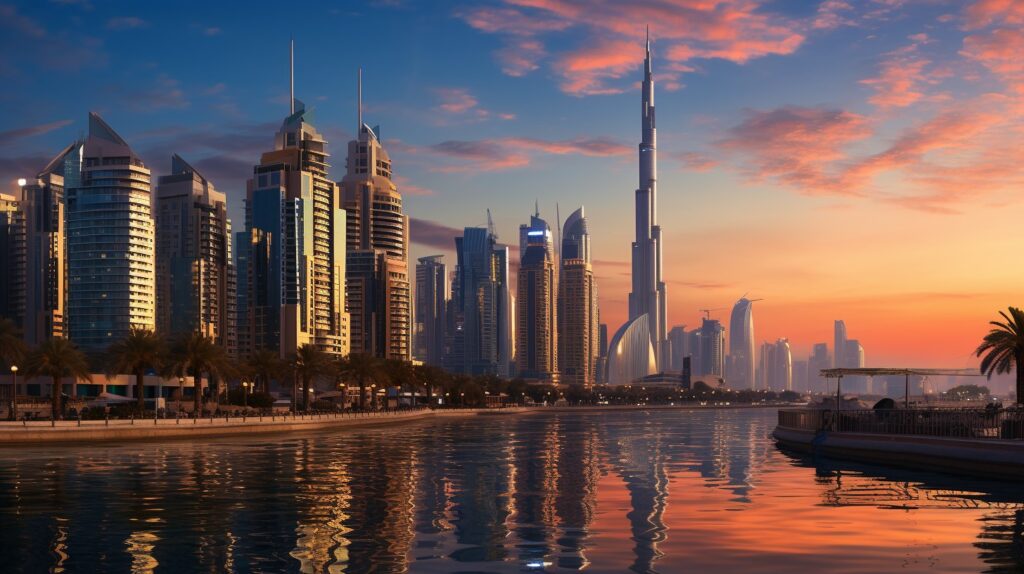Introduction
Dubai, a shimmering oasis in the desert, has long been a beacon for investors seeking to tap into its thriving real estate market. This dynamic city, known for its futuristic architecture and luxurious lifestyle, offers many investment opportunities. With the advent of digital platforms, investing in Dubai’s property market has evolved significantly. Today, the city’s real estate landscape can be navigated from the comfort of your home thanks to many online resources. This article delves deep into these tools, providing insights into Dubai property investments’ vibrant world and highlighting how online platforms are changing the game for investors worldwide.

Digital Platforms for Dubai Real Estate The digital revolution has transformed how investors engage with the Dubai real estate market. Websites like Bayut and Property Finder are at the forefront, offering comprehensive listings with detailed descriptions, high-resolution photos, and even virtual tours. These platforms allow you to filter properties based on location, price, type, and amenities, making the search tailored to your needs.
Mobile apps have also become indispensable. Apps like ‘Dubizzle’ provide real-time alerts on new listings and price changes, ensuring you never miss an opportunity. They also offer tools like mortgage calculators and investment ROI estimators. For example, the average price of a one-bedroom apartment in Downtown Dubai is around AED 1.2 million, with rental yields averaging 6%. These apps help calculate potential returns, considering mortgage rates currently average at around 3-4% in Dubai.
Analyzing Market Trends Online Understanding market trends is crucial for making informed investment decisions. Online platforms offer a wealth of data for market analysis. The Dubai Land Department reports a steady increase in property sales, with a significant spike in high-end areas like Palm Jumeirah and Dubai Marina. Websites like Zawya and Gulf News provide detailed market analysis, trends, and forecasts.
For example, a recent study highlighted that the average price per square foot in Dubai Marina has risen by 5.8% in the last year. Online tools also offer insights into rental yield trends, with areas like Jumeirah Village Circle offering average yields of 7.3%. Investors can track these trends over time, compare different neighborhoods, and even monitor construction progress on new developments, all online.
Highlighting Key Dubai Landmarks in Investment Areas Investing in Dubai also means being part of a city home to world-renowned landmarks. The Burj Khalifa, the world’s tallest building, is more than just an architectural wonder; it’s a hub for luxury real estate. Property in the Downtown area, which houses the Burj Khalifa, is highly sought after, with prices averaging AED 2,200 per square foot. The tower offers exclusive residences with state-of-the-art facilities, attracting a global clientele.
Another iconic development is The Palm Jumeirah, an artificial island that has redefined luxury living. It’s not just a prestigious address but a lifestyle choice, offering beachfront villas and apartments with spectacular views of the Arabian Gulf. The average price for a villa on The Palm is around AED 11.5 million, with properties offering amenities like private beaches and marinas. These landmarks are not just places of interest; they are integral to understanding the value dynamics of Dubai’s real estate market.
Understanding Developers and Projects
Dubai’s skyline, a canvas of architectural marvels, results from visionary work by renowned developers. Emaar Properties, a name synonymous with luxury, has been instrumental in shaping Dubai’s real estate landscape. They’re the masterminds behind the iconic Burj Khalifa and the sprawling Dubai Mall. Investing in an Emaar property means more than buying real estate; it’s buying into a legacy of quality and innovation. For instance, the average price of apartments in the Burj Khalifa by Emaar starts at around AED 2,200 per square foot, offering amenities like indoor pools, exclusive lounges, and breathtaking city views.
Another key player is Nakheel Properties, known for its ambitious projects like The Palm Jumeirah. Investing in a Nakheel property is investing in unique designs and strategic locations. The Palm Jumeirah, a feat of engineering, offers villas with private beaches and apartments with sea views, with prices averaging AED 1,400 per square foot. These developers provide properties and a lifestyle with luxury amenities and unparalleled locations.
The Dubai Properties Group, part of the Dubai Holding conglomerate, focuses on residential, commercial, retail, and hospitality projects, creating integrated communities like Jumeirah Beach Residence (JBR). A property in JBR offers a Mediterranean lifestyle with a blend of residential and commercial units. Prices here range from AED 1,000 to AED 1,800 per square foot, offering beachfront living with a mix of dining, shopping, and leisure activities right at your doorstep.
When considering these developers and their projects, exploring their online presence is essential. Their websites provide comprehensive details, from project brochures to virtual tours, allowing investors to make informed decisions. For example, Emaar’s website showcases upcoming projects with detailed floor plans, community amenities, and even 3D models of the properties.

Online Financial Tools and Resources
Investing in Dubai’s real estate market requires a sound understanding of the financial aspects. The digital age has brought many online tools and resources to simplify this process. Mortgage calculators on websites like Emirates NBD allow you to calculate monthly payments, interest rates, and loan tenures, providing a clear picture of your financial commitment. For example, for a property worth AED 2 million, with a 25-year mortgage at a 3.5% interest rate, the monthly payment would be approximately AED 9,000.
Investment ROI tools are also invaluable. These tools help calculate the return on investment, considering factors like rental yields, property appreciation, and maintenance costs. With Dubai’s average rental yield at 5-7%, these tools provide a roadmap for long-term profitability.
Furthermore, websites like the Dubai Land Department offer legal and tax implications insights. The DLD’s online portal provides information on property laws, registration fees, and other legalities associated with property investment in Dubai. For instance, there is a 4% transfer fee on the property value for every sale in Dubai, a crucial fact for every investor to consider.
Another aspect to consider is the online forums and expat communities, like Expat Forum and Dubai Forums, where investors and residents share experiences, advice, and insights. These platforms offer real-life perspectives on living and investing in Dubai, covering everything from property management to neighborhood reviews.
Online Financial Tools and Resources
When delving into Dubai’s real estate market, mastering the financial aspects is crucial. The digital era has ushered in online tools and resources, simplifying this complex process for investors. Mortgage calculators, a staple on banking websites like Emirates NBD, offer instant computations of monthly payments, interest rates, and loan tenures. For instance, they are purchasing an AED 2 million property with a 25-year mortgage at a 3.5% interest rate, resulting in monthly payments of approximately AED 9,000. This tool is invaluable for budgeting and long-term financial planning.
Investment Return on Investment (ROI) calculators are equally indispensable. They analyze potential returns considering rental yields, property appreciation, and ongoing costs. With Dubai’s rental yields averaging 5-7%, these calculators clearly show the investment’s profitability over time. They’re handy for comparing properties and areas, enabling investors to make data-driven decisions.
Legal and tax considerations are also a vital part of property investment. The Dubai Land Department (DLD) offers an online portal detailing property laws, registration procedures, and associated costs. For example, Dubai levies a 4% transfer fee on the property value at the time of sale, an essential factor for investors to account for in their calculations.
Another critical resource is online forums and communities such as Expat Forum and Dubai Forums. These platforms provide real-world insights from current investors and residents, offering advice on everything from property management to neighborhood-specific information. This peer-to-peer advice is often grounded in personal experience, providing a realistic view of the investment landscape in Dubai.

Highlighting Key Dubai Landmarks in Investment Areas
Investing in Dubai real estate is not just about acquiring property; it’s about becoming part of a community home to some of the world’s most iconic landmarks. The Burj Khalifa, the tallest building globally, is more than an architectural marvel; it’s a centerpiece in Downtown Dubai. Residences in the Burj Khalifa offer unparalleled luxury, with prices starting at around AED 2,200 per square foot. The building features state-of-the-art amenities, including indoor pools, exclusive sky lounges, and panoramic city views.
Another significant landmark influencing the real estate market is The Palm Jumeirah. Known for its unique palm-tree shape, this artificial island is a marvel of engineering and luxury living. Properties here are synonymous with exclusivity, offering beachfront villas and high-end apartments with views of the Arabian Gulf. Prices for villas on The Palm can reach upwards of AED 11.5 million, featuring amenities like private beaches and marinas.
These landmarks significantly impact the values of surrounding properties and the area’s overall appeal. The proximity to such landmarks often translates to higher property prices and greater demand, making them attractive investment opportunities. For instance, properties in Downtown Dubai, due to their proximity to the Burj Khalifa, have seen consistent appreciation and high demand, particularly from international investors.
Investing near these landmarks also means access to world-class facilities and amenities. The Dubai Mall, near the Burj Khalifa, is one of the largest shopping centers globally, offering an array of retail, dining, and entertainment options. Similarly, The Palm Jumeirah is home to luxury hotels, upscale restaurants, and exclusive beach clubs, enhancing the lifestyle appeal of properties in this area.
In conclusion, understanding Dubai’s real estate market requires a blend of financial savvy, facilitated by online tools, and a deep appreciation of the city’s iconic landmarks and their influence on property values and investment appeal. The synergy of these elements creates a unique investment landscape, offering opportunities for high returns and a luxurious lifestyle. As the article progresses, we will delve deeper into the nuances of Dubai’s real estate market, offering comprehensive insights for prospective investors.